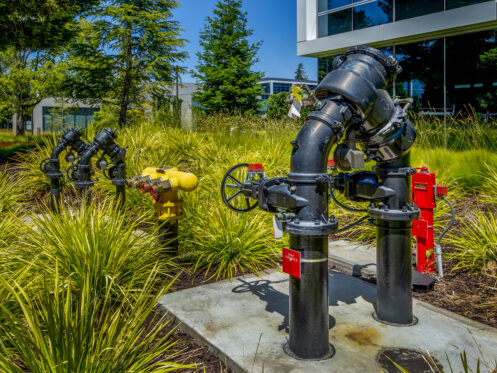Backflow testing protects the public’s health and guarantees adherence to safety requirements by preventing polluted water from recirculating into potable water sources. The best way for homeowners and property managers to keep their water systems safe and efficient is to learn about backflow, how it happens and the benefits of testing.
How Does Backflow Occur?
Backflow happens when the water flows in the opposite direction of its intended route, possibly contaminating your home’s water supply. This can happen when there is an abrupt change in the water pressure within the plumbing system. For instance, in the event of a water main breakage or an unexpected spike in water consumption, the system’s pressure can decrease. This leads to the reversal of water flow from an unsanitary source like a garden hose or a sewage line. That reversal of water then flows into your potable water supply.
How Does Plumbing Backflow Testing Work?
Backflow testing involves a trained expert evaluating the effectiveness of backflow protection devices with the help of specialized tools, like pressure gauges, test kits and flow meters. To test the device’s responsiveness, the technician will mimic scenarios that could trigger backflow. It may be necessary to fix or replace the device to guarantee the water supply remains protected if it does not satisfy the necessary criteria.
What Are the Benefits?
One of the most significant benefits of regular backflow testing is that it helps maintain a clean water supply, which is vital for your health and everyone living in the home. Secondly, it helps residents adhere to their community’s water safety rules. Regular testing also extends the life of backflow prevention devices and reduces the need to repair or replace them by identifying and resolving issues early.
Common Types of Backflow Prevention Devices
The plumbing industry makes extensive use of a variety of backflow protection devices, each tailored to a particular danger. Most commonly, you’ll see check valves, which open in one direction to allow water to flow but close in the other to stop backflow. Double-check valves provide an extra line of defense against backflow because they use two check valves instead of one. For extremely dangerous situations, you should install a pressure relief valve, which is also known as a reduced pressure zone (RPZ) valve. It will keep the pressure between the two check valves at a lower level, so that backflow cannot occur. Another crucial component is the air gap, which physically separates the water supply outlet from the flood-level rim of a fixture. This prevents contaminants from re-entering the clean water supply.
Who Should Perform Backflow Testing?
The accuracy of backflow testing and the resolution of any problems depend on the hiring of competent experts. Because of their extensive training and access to high-quality testing equipment, these specialists can decipher even the most intricate backflow prevention systems.
Frequency of Backflow Testing Requirements
Backflow testing criteria can vary for different types of properties and geographical areas. Backflow prevention devices are subject to annual testing requirements in various regions to guarantee continued compliance with safety regulations. More frequent testing may be necessary for high-risk buildings, including those with complicated plumbing systems or those connected to public water supplies. Before deciding on a testing plan for your property, it is crucial to research local requirements and seek advice from a plumbing expert.
How to Prep Your Property for Backflow Testing
There are a few essential steps you can take to prepare your property for the backflow testing. First things first, the technician needs easy access to a backflow prevention device. Clearing the area around the device will ensure that there isn’t anything that could get in the way of the testing process. Also, make sure the technician knows if there are any problems you’re having with the backflow prevention device.
These problems can range from inconsistent water pressure to visible leaks around the device. By giving precise information about the problems, you can ensure an accurate and comprehensive assessment. Finally, while the testing is underway, there will be a temporary disruption to your water service, so you’ll need to plan accordingly.
Winfrey Plumbing can answer any questions you may have about plumbing backflow testing. We also specialize in sewer and drain cleaning, water heater maintenance, commercial plumbing repairs, maintenance plans and more. Contact us today to book backflow testing for your home in Grand Island, NE.


